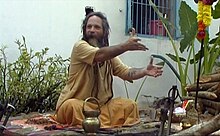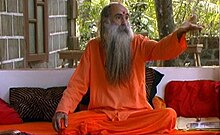Last hippie standing
| Movie | |
|---|---|
| Original title | Last hippie standing |
| Country of production | Germany |
| original language | English |
| Publishing year | 2001 |
| length | 45 minutes |
| Age rating | FSK 16 |
| Rod | |
| Director | Marcus Robbin , Ulrich Meczulat (Co-Director) |
| script | Marcus Robbin |
| production | Tangiji Film GbR |
| music |
Arnd Mechsner , Peter Aumeier , Peter Ziegelmeier |
| camera | Martin Roth, Jochen Hermann |
| cut |
Stefan Kobe , Marcus Robbin |
Last Hippie Standing is a 45-minute English-language documentary by the German documentary filmmaker Marcus Robbin about the hippie movement and the psytrance scene in Goa and especially in Anjuna in India . The film compares the hippie era in the 1960s and 1970s with the situation in 2000.
content

The documentation, which is largely without a speaker, consists of recordings of the ongoing party culture in Goa, excerpts from private film recordings from the seventies, as well as conversations with travelers, locals and local officials who remained at the site after the hippie trail , such as the chief minister of Goa, Francisco Sardinha .
The “hippie area” of Goa initially appears as a small party enclave for younger hippie tourists in the middle of the more earthly and down-to-earth Indian Goa, whose residents view the goings-on there with mixed feelings, but welcome the opportunities for their own livelihood. For the local authorities, too, practical problems are in the foreground, such as the economic factor tourism or the drug problem. With the help of interviews with long-established hippies, such as the DJ Goa Gil , the dropout Swami William and old film recordings, the authors try to illustrate the motives and circumstances behind the settlement of hippies in Goa in the 1960s and 1970s. Towards the end of the film, it is about the legacy of the hippie movement, about psytrance , yoga and expanding consciousness as well as the relationship to the Love Parade movement at the turn of the millennium.
Origin and Distribution
The documentary contains film material shot on Super8 , the only surviving film document of this time in Goa. The scenarios were filmed by the author Cleo Odzer , who was also interviewed as a contemporary witness for the film and who died in the year it was published. The film was then dedicated in memory of Odzer.
The documentary received no film funding or support from the German television stations that did not want to take up the topic in the form presented.
The film gained increasing popularity on the Internet.
It was written in December 1999 and January 2000 with an estimated budget of $ 20,000 . The film was distributed on DVD in 2004 by the Japanese company Nowonmedia.
Individual evidence
- ↑ http://www.imdb.de/title/tt0385048/
- ↑ Business data on imdb.com
Web links
- lasthippiestanding.de (official homepage)
- Last Hippie Standing in the Internet Movie Database (English)
- Last Hippie Standing (full documentation)
- Last Hippie Standing (full documentation)
